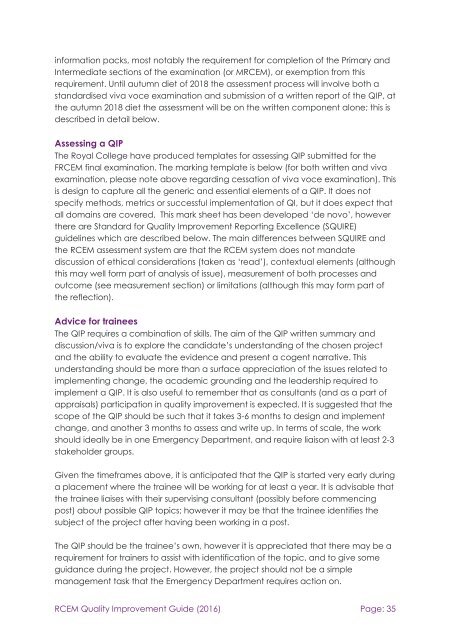RCEM QUALITY IMPROVEMENT GUIDE
2fvpeHu
2fvpeHu
You also want an ePaper? Increase the reach of your titles
YUMPU automatically turns print PDFs into web optimized ePapers that Google loves.
information packs, most notably the requirement for completion of the Primary and<br />
Intermediate sections of the examination (or M<strong>RCEM</strong>), or exemption from this<br />
requirement. Until autumn diet of 2018 the assessment process will involve both a<br />
standardised viva voce examination and submission of a written report of the QIP, at<br />
the autumn 2018 diet the assessment will be on the written component alone; this is<br />
described in detail below.<br />
Assessing a QIP<br />
The Royal College have produced templates for assessing QIP submitted for the<br />
F<strong>RCEM</strong> final examination. The marking template is below (for both written and viva<br />
examination, please note above regarding cessation of viva voce examination). This<br />
is design to capture all the generic and essential elements of a QIP. It does not<br />
specify methods, metrics or successful implementation of QI, but it does expect that<br />
all domains are covered. This mark sheet has been developed ‘de novo’, however<br />
there are Standard for Quality Improvement Reporting Excellence (SQUIRE)<br />
guidelines which are described below. The main differences between SQUIRE and<br />
the <strong>RCEM</strong> assessment system are that the <strong>RCEM</strong> system does not mandate<br />
discussion of ethical considerations (taken as ‘read’), contextual elements (although<br />
this may well form part of analysis of issue), measurement of both processes and<br />
outcome (see measurement section) or limitations (although this may form part of<br />
the reflection).<br />
Advice for trainees<br />
The QIP requires a combination of skills. The aim of the QIP written summary and<br />
discussion/viva is to explore the candidate’s understanding of the chosen project<br />
and the ability to evaluate the evidence and present a cogent narrative. This<br />
understanding should be more than a surface appreciation of the issues related to<br />
implementing change, the academic grounding and the leadership required to<br />
implement a QIP. It is also useful to remember that as consultants (and as a part of<br />
appraisals) participation in quality improvement is expected. It is suggested that the<br />
scope of the QIP should be such that it takes 3-6 months to design and implement<br />
change, and another 3 months to assess and write up. In terms of scale, the work<br />
should ideally be in one Emergency Department, and require liaison with at least 2-3<br />
stakeholder groups.<br />
Given the timeframes above, it is anticipated that the QIP is started very early during<br />
a placement where the trainee will be working for at least a year. It is advisable that<br />
the trainee liaises with their supervising consultant (possibly before commencing<br />
post) about possible QIP topics; however it may be that the trainee identifies the<br />
subject of the project after having been working in a post.<br />
The QIP should be the trainee’s own, however it is appreciated that there may be a<br />
requirement for trainers to assist with identification of the topic, and to give some<br />
guidance during the project. However, the project should not be a simple<br />
management task that the Emergency Department requires action on.<br />
<strong>RCEM</strong> Quality Improvement Guide (2016) Page: 35


